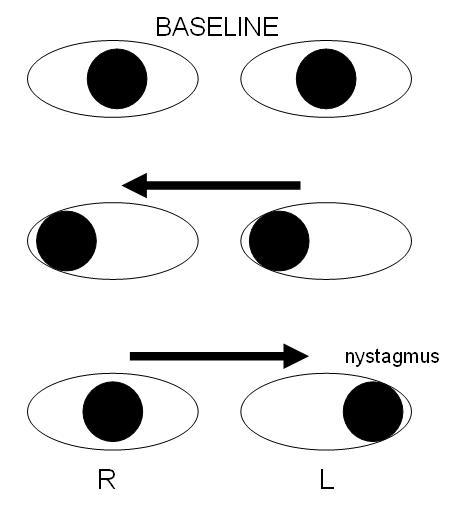Multiple sclerosis physical examination: Difference between revisions
(Created page with "=== Internuclear ophthalmoplegia === [[Image:Internuclear ophthalmoplegia.jpg|thumb|right|180px|''Schematic demonstrating right internuclear ophthalmoplegia, caused by injury...") |
No edit summary |
||
| Line 7: | Line 7: | ||
Internuclear ophthalmoplegia occurs when MS affects a part of the [[brain stem]] called the [[medial longitudinal fasciculus]], which is responsible for communication between the two eyes by connecting the [[abducens nucleus]] of one side to the [[oculomotor nucleus]] of the opposite side. This results in the failure of the [[medial rectus muscle]] to contract appropriately, so that the eyes do not move equally (called disconjugate gaze). | Internuclear ophthalmoplegia occurs when MS affects a part of the [[brain stem]] called the [[medial longitudinal fasciculus]], which is responsible for communication between the two eyes by connecting the [[abducens nucleus]] of one side to the [[oculomotor nucleus]] of the opposite side. This results in the failure of the [[medial rectus muscle]] to contract appropriately, so that the eyes do not move equally (called disconjugate gaze). | ||
===Optic neuritis=== | |||
Up to 50% of patients with MS will develop an episode of optic neuritis, and 20% of the time optic neuritis is the presenting sign of MS. The presence of demyelinating white matter lesions on brain [[MRI]] at the time of presentation of optic neuritis is the strongest predictor for developing clinically definite MS. Almost half of the patients with optic neuritis have white matter lesions consistent with multiple sclerosis. | |||
At five years follow-up, the overall risk of developing MS is 30%, with or without MRI lesions. Patients with a normal MRI still develop MS (16%), but at a lower rate compared to those patients with three or more MRI lesions (51%). From the other perspective, however, almost half (44%) of patients with any demyelinating lesions on MRI at presentation will not have developed MS ten years later. <ref>{{cite journal |author=Beck RW, Trobe JD |title=What we have learned from the Optic Neuritis Treatment Trial|journal=Ophthalmology |volume=102 |issue=10 |pages=1504-8 |year=1995 |pmid=9097798}}</ref><ref>{{cite journal |author= |title=The 5-year risk of MS after optic neuritis: experience of the optic neuritis treatment trial. 1997 |journal=Neurology |volume=57|issue=12 Suppl 5 |pages=S36-45 |year=2001 |pmid=11902594}}</ref> | |||
Revision as of 14:26, 27 August 2012
Internuclear ophthalmoplegia

Internuclear ophthalmoplegia is a disorder of conjugate lateral gaze. The affected eye shows impairment of adduction. The partner eye diverges from the affected eye during abduction, producing diplopia; during extreme abduction, compensatorynystagmus can be seen in the partner eye. Diplopia means double vision while nystagmus is involuntary eye movementcharacterized by alternating smooth pursuit in one direction and a saccadic movement in the other direction.
Internuclear ophthalmoplegia occurs when MS affects a part of the brain stem called the medial longitudinal fasciculus, which is responsible for communication between the two eyes by connecting the abducens nucleus of one side to the oculomotor nucleus of the opposite side. This results in the failure of the medial rectus muscle to contract appropriately, so that the eyes do not move equally (called disconjugate gaze).
Optic neuritis
Up to 50% of patients with MS will develop an episode of optic neuritis, and 20% of the time optic neuritis is the presenting sign of MS. The presence of demyelinating white matter lesions on brain MRI at the time of presentation of optic neuritis is the strongest predictor for developing clinically definite MS. Almost half of the patients with optic neuritis have white matter lesions consistent with multiple sclerosis. At five years follow-up, the overall risk of developing MS is 30%, with or without MRI lesions. Patients with a normal MRI still develop MS (16%), but at a lower rate compared to those patients with three or more MRI lesions (51%). From the other perspective, however, almost half (44%) of patients with any demyelinating lesions on MRI at presentation will not have developed MS ten years later. [1][2]